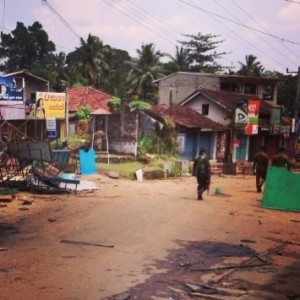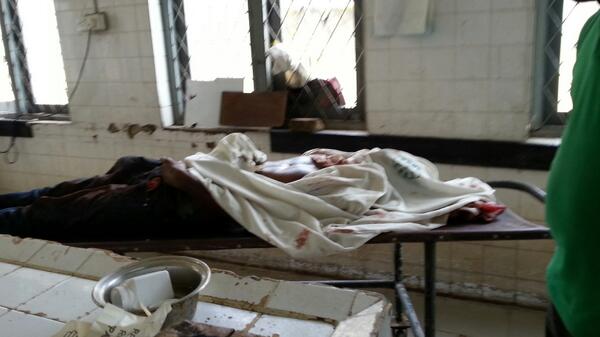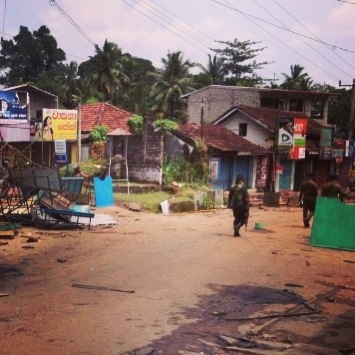WELIWERIYA, GAMPAHA: BLACK THURSDAY 2013 By DR DAYAN JAYATILLEKA
 |
| pic courtesy of: twitter.com/azzamameen |
Who deployed troops, clad in flak jackets (body armour) and armed with T-56 assault rifles to confront and disperse a crowd of protestors blocking a highway? Who was the ultimate decision-maker? The protestors were not armed, certainly not with lethal weapons. Therefore, no real harm could have come to soldiers in body armour. A ‘clash’ between lethally armed soldiers and protestors with stones and slippers is not a clash that warrants in any way, the use of lethal force.
The crucial question must then be posed: who gave the order for a military unit armed with deadly force to be deployed against an unarmed civic protest, in a situation where the normal law prevails and a state of Emergency has not been declared because it was manifestly not warranted? What was the chain of command responsibility? Why was the task not left to the riot police? The question of who gave the order to shoot and for what reasons is a secondary one.
I find it impossible to believe, that on his first day as Army commander, the able and sophisticated Gen Daya Ratnayake, a thinking soldier, would have made this decision. I find it no less implausible that Mahinda Rajapaksa, whose mode for decades has been to use the strengths of his personality for dialogue and dissembling, to charm Southern constituencies, would have opted for martial methods, at the commencement of an election campaign. So the mystery remains, if mystery it is.
What was the logic of sending in troops? Why were they wearing body armour? Why were they carrying T-56 assault rifles? Since when are troops sent in crowd control situations in which there are men, woman, children and clergymen, none of whom have been spotted as carrying lethal weapons? It is not as if the protestors were tossing Molotov cocktails at the police who could therefore not control the crowd.
What are the implications of the decision to deploy troops with assault rifles, when there is no State of Emergency? Is it that the army will henceforth be used against unarmed demonstrators in the South? In an earlier step on the escalation ladder, the STF had been used, against a protest by fisher-folk. Specialised army units were then used to suppress, with an entirely one sided result and massive casualties, a prison riot. Now the army has been deployed against unarmed demonstrators in the South or shall we say the non-former conflict zones.
Picture is seen the succumbed Akila Dinesh (17) at Gampaha District General Hospital: pic via: Sanka Vidanagama
Ah, but could it have been a conspiracy against the country? Doesn’t the shooting come just on the first of the very month that UN High Commissioner for Human Rights visits Sri Lanka, in fact just three weeks before the visit? Could it not been a force hostile to Sri Lanka that spread the rumour of toxic waste, brainwashed the protestors into excessive concern about the quality of their drinking water and the health of their children, bribed them into protesting on the streets, and armed them lethally with slippers and stones? Perhaps it was all part of an Arab Spring ‘regime change’ strategy—the crucial move of which was to send in the indispensable ingredient for the crime: troops with assault rifles and body armour. Thus we must be unafraid to ask ourselves whether it was the CIA, the NSA, the RAW, the ‘13A Nazis’, the Halal imposing Koran thumpers, Justice Wigneswaran, Karunanidhi and Jeyalalitha, or Fr Emmanuel and Lawrence Rudrakumaran who gave the order.
How will the world view Sri Lanka after the events of yesterday? Having known and sparred successfully in defence of our country’s sovereignty with two, not just one, UN High Commissioners for Human Rights – Louise Arbour and Navi Pillay—I can say with confidence and dismay, that Weliweriya would only substantiate the call for an international inquiry and the demand for the opening of an office of the High Commissioner in Sri Lanka. When I opposed it in 2007-2009, we could credibly claim to hold the moral high ground since we were fighting a fascistic foe. The demonstrators in Weliweriya who faced lethal force hardly fall into the same category as the suicide-terrorist Tigers and therefore our refusal of an office of the High Commissioner to monitor human rights abuses would lack the moral credibility it once had.
The obvious observations will be, if this is how the State authorities treat unarmed Sinhalese, largely Buddhist civilian men, women and children who are protesting against polluted water, how must that state have treated the Tamils in the closing stages of the war? How could authorities who didn’t care about possible casualties when sending in armed troops into unarmed crowds, care enough about Tamil civilians in the last days of and the morning after the war? If Weliweriya demonstrates the policy of the State and how the forces of the state behave towards the Sinhalese, how must they have conducted themselves in the North and East for thirty years and how must they be functioning in the former conflict zones today?
The argument of national sovereignty as currently deployed by the state and its ideologues, has a hole shot through it after the Gampaha killing. National sovereignty and popular sovereignty are twins. National/state sovereignty refers to external threats, those from outside our borders, and does not confer license to override popular sovereignty, the sovereignty of the citizen, most especially in a state constitutionally defined and designated a democratic Republic since 1972.
Coming in the run-up to the Northern Provincial Council election, the question cannot but be posed as to whether the Establishment which sent lethally armed soldiers to confront a crowd of unarmed civilians in the Gampaha district yesterday, will do otherwise, or deploy less force, if faced with peaceful protests over, let us say, issues of land seizure in the North. What if school-children, nuns, or elected members of the Provincial Council are shot or disappeared? Will that not trigger a surge in Tamil Nadu, followed by a demarche from Delhi in an election year? Will this not open the road to R2P?
30 years after Black July 83, a disturbing thought strikes me: Was Kuttimani right when he said 30 years ago, in his final speech in the Colombo High Court– months before he was slaughtered in Welikada jail– that the brutal methods used in Gurunagar army camp would come home to the south one day?
[Dr. Dayan Jayatilleka was Sri Lanka’s Ambassador/Permanent Representative to the United Nations in Geneva 2007-9 and Vice–President of the United Nations Human Rights Council, 2007-2008]
– courtesy DBS.com
